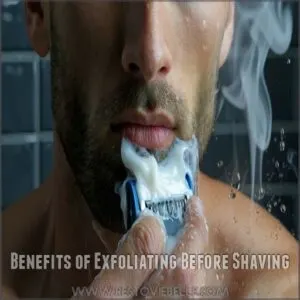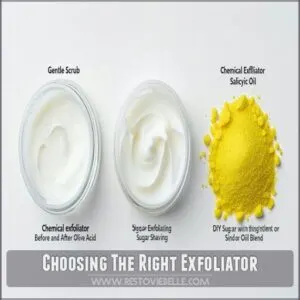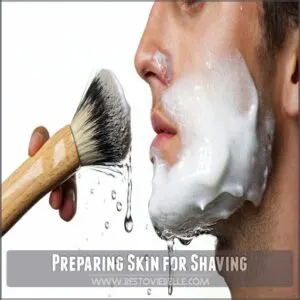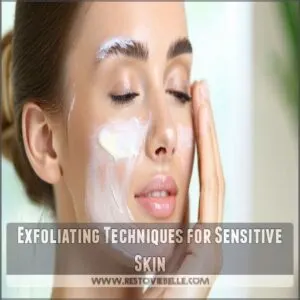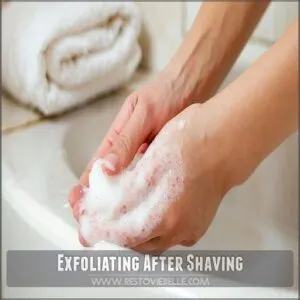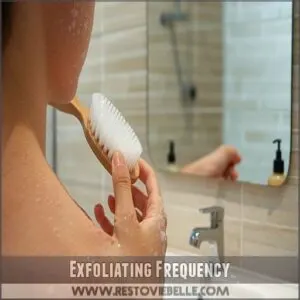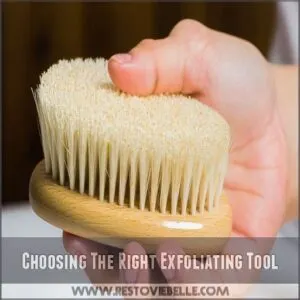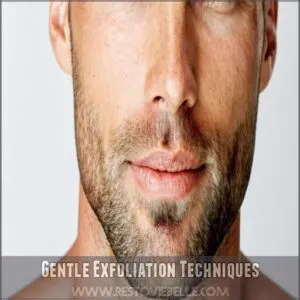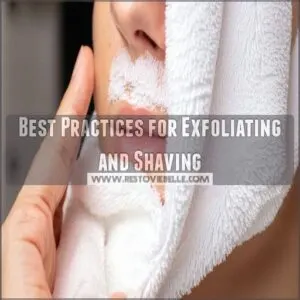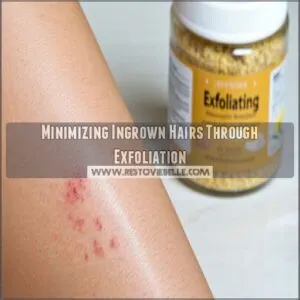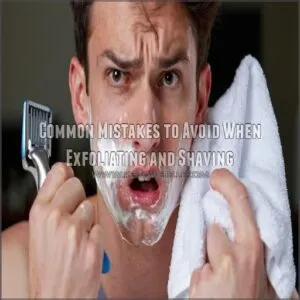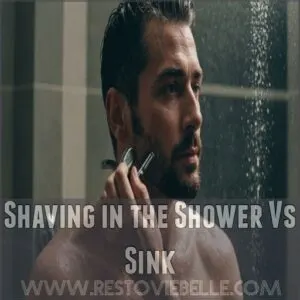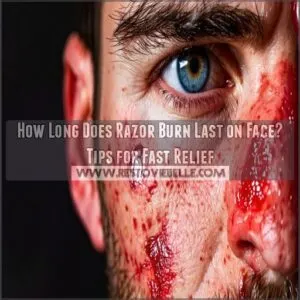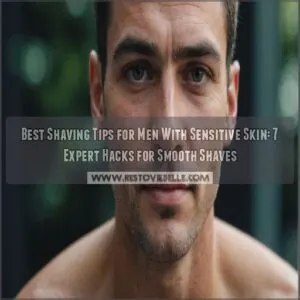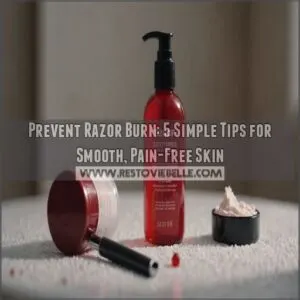This site is supported by our readers. We may earn a commission, at no cost to you, if you purchase through links.
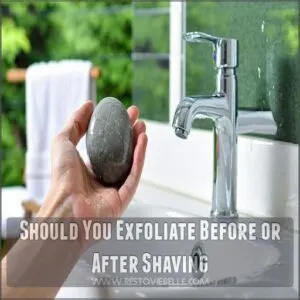 You should exfoliate before shaving to achieve a smoother and closer shave.
You should exfoliate before shaving to achieve a smoother and closer shave.
Think of it this way: exfoliating acts like clearing the path for your razor, removing dead skin cells that might clog the blades.
This helps the razor glide effortlessly and reduces the risk of post-shave irritation.
The Cleveland Clinic agrees that this can also help prevent the pesky ingrown hairs we all dread.
So, before you lather up, give your skin a gentle scrub.
It’s a small step with big benefits, setting the stage for a perfect shave.
Curious about the best exfoliating techniques? Keep reading!
Table Of Contents
- Key Takeaways
- Benefits of Exfoliating Before Shaving
- Should You Exfoliate Before or After Shaving
- How to Exfoliate Before Shaving
- Exfoliating After Shaving
- Tips for Effective Exfoliation
- Best Practices for Exfoliating and Shaving
- Minimizing Ingrown Hairs Through Exfoliation
- Common Mistakes to Avoid When Exfoliating and Shaving
- Frequently Asked Questions (FAQs)
- Is it better to shave or exfoliate first?
- What is the correct way to shave and exfoliate?
- Should you exfoliate before or after shaving pubic area?
- Should you exfoliate on dry or wet skin?
- How does exfoliation impact shaving frequency?
- What exfoliating techniques are best for sensitive skin?
- Can exfoliating worsen razor bumps and burns?
- How long should skin rest between exfoliation and shaving?
- Do different skin types require unique exfoliation methods?
- Conclusion
Key Takeaways
- Exfoliate before shaving to remove dead skin cells, ensuring a smoother, irritation-free shave and preventing ingrown hairs.
- Use gentle exfoliators suitable for your skin type to avoid irritation and maintain skin health.
- Moisturize after shaving to hydrate your skin and enhance the close shave’s effects.
- Waiting a day between exfoliating and shaving reduces irritation, allowing your skin to recover.
Benefits of Exfoliating Before Shaving
Exfoliating before shaving gives you a smoother shave by removing dead skin cells and letting your razor glide effortlessly.
Exfoliating also helps reduce skin irritation and prevents ingrown hairs, making your shaving routine a lot more pleasant.
Smoother Shave Experience
A good shave starts with smooth skin, thanks to exfoliating before shaving. This simple step reveals softer skin and makes hair easier to cut. Using a low pH cleanser and warm water for pre-shave exfoliation, as part of a solid pre-shave face washing routine, helps prepare your skin for shaving.
- Razor burn prevention starts with understanding your skin type and knowing how to prevent razor burn, and can lead to a closer shave with fewer nicks.
- Ingrown hair prevention: Buffs away dead skin cells.
- Skin irritation reduction: Less tugging.
- Best shaving products: Work their magic effectively.
- Shaving techniques: Enhanced precision.
Reduced Skin Irritation
A smooth shave is about comfort, too.
Think of exfoliating as your secret weapon against irritation.
Before you take that blade to your skin, gently exfoliate to remove dead skin cells.
This helps your shaving products create a stronger barrier between skin and razor, minimizing razor burn and reducing redness.
Your sensitive skin will thank you for it!
Ingrown Hair Prevention
Preventing ingrown hairs starts with smart exfoliation.
It clears dead skin cells and leftover gunk, lowering your chances of those pesky bumps.
Here’s how:
- Use exfoliating products: A gentle scrub preps your skin.
- Incorporate into your skin care routine: Do it regularly.
- Try different hair removal techniques: Find what works best.
Say goodbye to ingrown hair troubles!
Should You Exfoliate Before or After Shaving
Wondering whether to exfoliate before or after shaving? It’s a bit like deciding between the chicken or the egg, but this one has a straightforward answer. Exfoliating before you shave is typically best.
Why? Because it creates a smoother canvas by removing dead skin cells and unclogging pores, which helps your razor glide effortlessly and reduces skin irritation. This pre-shave ritual can be particularly beneficial if you’re prone to ingrown hairs, offering them little chance to mess with your smooth finish.
But don’t toss post-shave exfoliation out the window just yet. It can also help maintain your skin’s texture and clarity. By exfoliating afterward, you’re addressing those sneaky ingrown hairs that may pop up. Overall, the two-step exfoliation—before and days after shaving—can keep your skin looking its best. So grab your favorite scrub and see the difference! It’s all about finding the balance that works for your skin.
How to Exfoliate Before Shaving
Getting ready for a smooth shave starts with prepping your skin.
Exfoliate before shaving, so you can avoid irritation and get the closest, most comfortable shave possible.
Choosing The Right Exfoliator
Choosing the right exfoliator makes all the difference.
Whether it’s oily or dry, your skin type guides the choice.
Consider these options:
- Scrub vs. Brush: Physical exfoliators like a gentle scrub can work wonders.
- Chemical vs. Physical: Salicylic acid for a deeper clean.
- DIY Options: Sugar and olive oil blend for a budget-friendly, natural choice.
Preparing Skin for Shaving
Picking the right exfoliator is only half the battle—your pre-shave routine‘s golden ticket lies in effective skin prep.
Start by soaking your skin with warm water to make those hairs softer.
Next, lather up with a shaving product that’s got that slick glide.
Using an exfoliating scrub reveals fresher skin, paving the way for smoother shaving and reduced irritation.
Exfoliating Techniques for Sensitive Skin
Everyone’s got sensitive skin stories—like when that scrub felt more like sandpaper.
For gentle exfoliation, opt for mild scrubs or soft loofahs.
Look for safe ingredients like oatmeal or aloe.
Sensitive skin care is all about being gentle while using the right exfoliating tools.
Exfoliating with a face scrub a few times per week, like those with natural exfoliating beads containing jojoba and soothing ingredients, can help remove dead skin cells and prevent ingrown hairs. This way, you’ll prep your skin beautifully for a smooth shave without irritation.
Exfoliating After Shaving
Exfoliating after shaving can help prevent irritation, especially in sensitive areas like the cheeks and neck, which are prone to razor burn and ingrown hairs. Exfoliating after shaving helps keep your skin smooth and clear by removing any dead skin cells left behind.
It also reduces the chances of pesky ingrown hairs and razor bumps, promoting healthier skin in the days following your shave.
Why Exfoliate After Shaving
Exfoliating after shaving’s an unsung hero in your smooth-skin routine. It helps keep those pesky razor bumps and ingrown hairs at bay. Plus, it reduces dryness and maintains your shave’s freshness.
Consider these benefits:
- Smooth skin: Removes dead cells.
- Prevent ingrown hairs: Frees trapped hair.
- Minimize razor bumps: Soothes skin texture.
- Reduce dryness: Enhances moisture retention.
How to Exfoliate After Shaving
When you’ve just shaved, gently exfoliate using a mild scrub or exfoliating tool a day or two later.
This helps clear away dead skin cells and keeps your skin fresh.
Opt for the best exfoliators suited for sensitive skin.
Keep it light and easy, embracing exfoliating frequency to promote smoothness.
Your post-shave routine deserves this touch for an ingrown hair fix.
Reducing Razor Bumps and Ingrown Hairs
Because razor bumps and ingrown hairs are annoying, gentle exfoliation after shaving can be your secret weapon.
A day or two after shaving, use a mild scrub to lift away dead skin cells.
This simple step prevents ingrown hairs from getting trapped.
You’ll notice smoother skin and fewer bumps, proving that a little exfoliation goes a long way in your shaving routine.
It’s a simple addition to your skin care tips for a better shave.
Tips for Effective Exfoliation
Effective exfoliation is all about choosing the right frequency and tools to keep your skin smooth and healthy.
You’ll want to use gentle techniques that suit your skin type, ensuring you don’t overdo it and cause irritation.
Exfoliating Frequency
Finding the right exfoliating frequency isn’t a one-size-fits-all game.
It’s about understanding your skin type and exfoliator type, and you can browse a variety of products, like physical face scrub, to find what works best for you.
If you’ve got dry skin, aim for one to two sessions per week.
For oily skin, daily exfoliation can be your match.
Adjust as needed, listening to what your skin tells you, ensuring it’s comfortable and happy.
Choosing The Right Exfoliating Tool
You’ve nailed the frequency, now let’s pick the right tool.
Are you a scrub gal or a brush buff?
It hinges on your skin’s whispers.
Got sensitive skin? Opt for a gentler vibe, like a light scrub.
Coarser skin? A brush might be your jam.
Choose wisely, like picking the perfect grit for sandpaper—smooth sailing ahead!
Gentle Exfoliation Techniques
Think of exfoliating as a dance where you control the tempo: light pressure is key.
For good skin health, incorporating best exfoliators for men into your routine can help tackle problems like ingrown hairs and razor burn.
Use micro-scrubs or gentle loofahs for skin sensitivity and pressure control.
These exfoliating tools keep your skin smooth without irritation.
Imagine your skin sighing with relief as you treat it with care – soft and invigorated, ready for a perfect shave.
Best Practices for Exfoliating and Shaving
Exfoliating before and after shaving each has its perks, whether it’s prepping your skin for a smooth shave or keeping it fresh and bump-free afterward.
Exfoliating before shaving helps prep your skin for a smooth shave.
Exfoliating after shaving helps keep your skin fresh and bump-free.
By using gentle techniques and the right products, you’ll keep your skin looking smooth and feeling great.
Exfoliating Before or After Showering
Exfoliating before showering can enhance your routine by prepping your skin to better absorb moisturizing products.
Since exfoliating is like giving your pores a little spring clean, don’t skip that chance to remove dead skin.
Consider how a face mask before showering can also help lock in moisture for dry skin.
Whether you choose to exfoliate pre-shower, during, or after, tailor it to your schedule.
Think of it as pampering your skin!
Shaving Techniques for Sensitive Skin
Showering first softens your skin and hair, prepping them for a smoother shave.
When it comes to shaving, using the right techniques and products, such as best sensitive skin shave cream, can make a big difference. Now, let’s talk shaving techniques for sensitive skin.
Here’s how to conquer razor burn prevention:
- Use a quality shaving cream; avoid harsh chemicals.
- Shave with the grain first, then against it for a closer shave.
- Rinse your razor frequently to prevent clogging.
- Gentle, short strokes minimize irritation. Remember, patience is key!
Moisturizing After Shaving
Handling sensitive skin when shaving isn’t just about technique.
To minimize irritation and prevent razor burn, using a sharp razor and shaving with the grain of hair growth are essential shaving tips especially when shaving sensitive areas. After shaving, moisturizing is key to preventing razor burn and soothing dryness.
Use a best moisturizer enriched with hydrating ingredients to lock in moisture and get rid of rough patches.
Think of it as giving your skin a well-deserved drink after all that shaving cream and blade work.
Minimizing Ingrown Hairs Through Exfoliation
Ingrown hairs can be pesky and uncomfortable, but exfoliation is your ally in preventing them.
By regularly removing dead skin cells and unclogging pores, you make it easier for new hair to grow straight and free.
Causes of Ingrown Hairs
While acing the art of shaving, tackling the pesky problem of ingrown hairs is key.
Sometimes, hair has a mind of its own, curling under the skin.
Using an exfoliating body scrub can help remove dead skin cells, making it less likely for hairs to become trapped.
Factors include:
- Hair growth direction: hair that curls easily.
- Dead skin buildup: can trap hairs.
- Razor bumps: from improper shaving.
- Tight clothing: adds unwelcome pressure.
Consider these when planning your skincare routine.
Exfoliating to Prevent Ingrown Hairs
Ingrown hairs can be a real nuisance, but you’ve got tools to fight back.
Exfoliating effectively reduces ingrown hairs by clearing dead skin cells and releasing trapped hair follicles.
Opt for the best exfoliators for ingrown hairs—sugar scrubs or gentle microbeads work wonders.
Make exfoliating for ingrown hairs part of your routine for smoother, bump-free skin.
Additional Tips for Preventing Ingrown Hairs
You’ve tackled exfoliation to keep ingrown hairs at bay, but there’s more to think about.
Use sharp razors and shave in the direction of hair growth. This minimizes irritation.
Incorporate specialized ingrown hair treatments into your skin care routine, and explore various hair removal techniques to find what reduces your bumps.
Don’t skip testing new exfoliating products to find your skin’s match.
Common Mistakes to Avoid When Exfoliating and Shaving
When exfoliating and shaving, it’s easy to make common mistakes that can irritate your skin, like exfoliating too frequently or using the wrong tools.
Don’t forget to moisturize after shaving to keep your skin smooth and hydrated.
Exfoliating Too Frequently
Overdoing it with exfoliation? That’s a common shaving mistake! Too much scrubbing can backfire, leading to several issues.
- Skin irritation flares up.
- Dryness becomes a problem.
- Redness shows up.
- Your skin’s protective barrier gets damaged.
- Over-exfoliation is a real thing.
Aim for a balance; less is often more for healthy, happy skin.
Using The Wrong Exfoliating Tool
Picking the wrong scrub can turn your skin into an itchy mess.
Your skin’s screaming for help, not just from overdoing the process.
Using a scrub that’s too harsh, like those containing synthetic beads in physical exfoliants, can be especially problematic.
With every rub, you risk irritation and disaster if you choose an inappropriate exfoliator.
Understand different scrub types and avoid pushing too hard.
Exfoliation frequency matters, too, so don’t go overboard every time!
Not Moisturizing After Shaving
After ditching the wrong tool, don’t skip moisturizing post-shave.
It’s like leaving a garden unwatered—it’ll dry out, leading to cracks and irritation.
A good moisturizer seals skin health, fighting razor burn and ingrown hairs while keeping dryness and irritation at bay.
Pamper your skin with a luscious layer of hydration, and enjoy that smooth, nourished feel.
Frequently Asked Questions (FAQs)
Is it better to shave or exfoliate first?
Did you know 80% of shavers see smoother skin by exfoliating first?
Exfoliate to remove dead skin cells and prevent razor clogging, then shave.
You’ll enjoy a closer, irritation-free shave and healthier skin.
Give it a try!
What is the correct way to shave and exfoliate?
Start by exfoliating in the shower with warm water to remove dead skin cells and unclog pores.
This prepares your skin for a closer, smoother shave.
Moisturize after shaving to lock in hydration and enhance smoothness.
Should you exfoliate before or after shaving pubic area?
Exfoliate before shaving down there to prevent ingrown hairs and razor burn. Afterwards, moisturize to keep things smooth. Trust me, your downstairs will thank you!
Should you exfoliate on dry or wet skin?
Exfoliating on wet skin is best because it helps soften the skin and opens pores, making it easier to remove dead cells.
Exfoliating in the shower with warm water offers the best results and prevents irritation.
How does exfoliation impact shaving frequency?
Smooth skin starts with scrubbing.
Exfoliating can extend the time between shaves by removing dead cells, leading to a closer, longer-lasting shave.
Keep a keen eye on your skin, adjusting your routine for the best results.
What exfoliating techniques are best for sensitive skin?
For sensitive skin, use gentle exfoliators like micro-scrubs or loofahs with light pressure.
These options minimize irritation while still effectively removing dead skin cells.
Opt for products with soothing ingredients like aloe or chamomile for added calmness.
Can exfoliating worsen razor bumps and burns?
Some folks worry that exfoliating might stir up razor bumps or burns.
But when done right—gently and not too often—exfoliation prevents these issues by removing dead skin and unclogging pores, keeping your skin smooth and clear.
How long should skin rest between exfoliation and shaving?
Give your skin at least a day to rest between exfoliating and shaving.
This downtime lets your skin recover, reducing irritation.
If it’s impatient like a jittery coffee lover, waiting a few hours might suffice.
Do different skin types require unique exfoliation methods?
Think of your skin like a garden: different types need unique care.
Oily skin thrives with daily gentle exfoliation, while dry skin benefits from a gentler touch once or twice a week.
Manage accordingly for ideal results.
Conclusion
So, you’ve learned the benefits of exfoliation! Did you know that a smooth shave can improve your confidence by as much as 20%?
Remember, exfoliating before shaving is key for a closer, irritation-free shave.
Should you exfoliate before or after shaving? Always before! Exfoliating with a gentle mechanical scrub or a chemical exfoliant containing alpha-hydroxy acids, such as treat razor bumps, helps remove dead skin cells before shaving. This simple step removes dead skin, preventing ingrown hairs and razor burn.
After shaving, moisturize to lock in that smooth, confident feeling. Now go forth and conquer your day – one smooth shave at a time!
